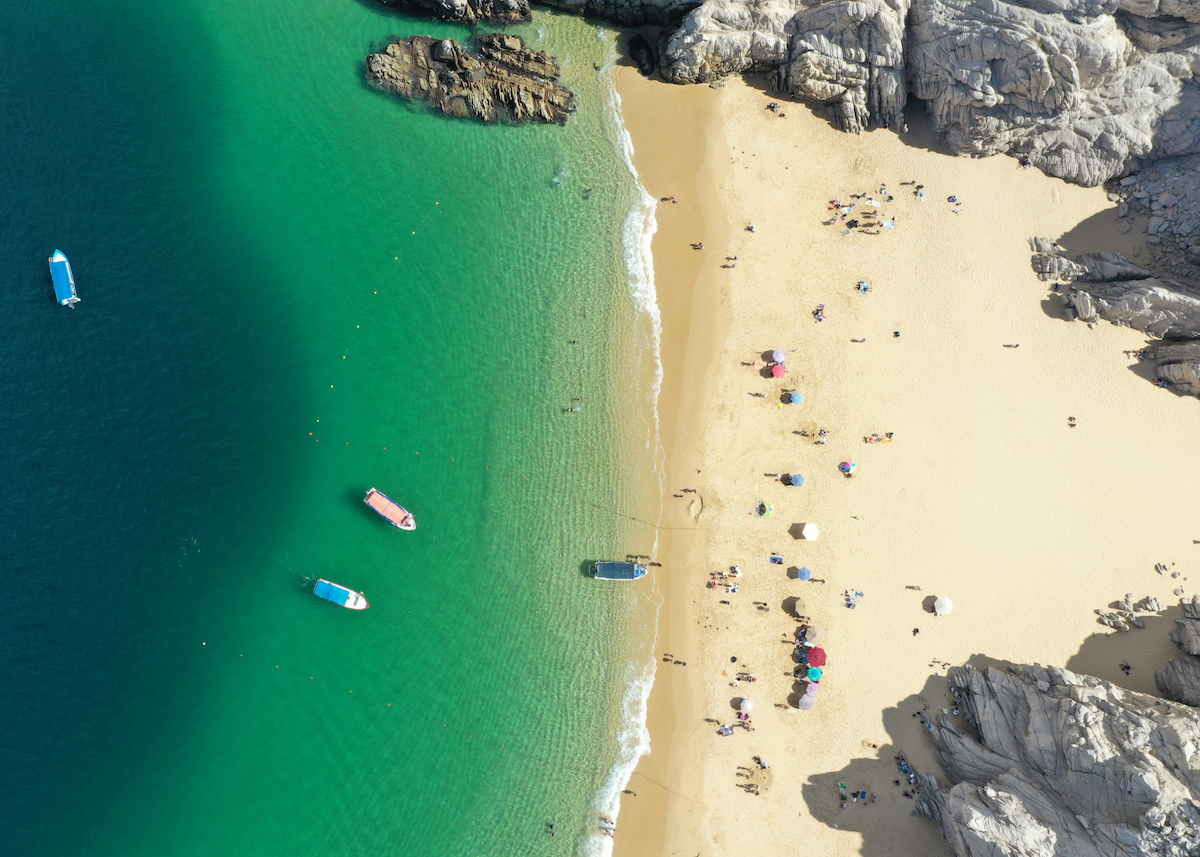
Summer in Mexico | Epic Festivals & Fun in the Sun
Summer in Mexico might be the hot and rainy season, but there’s still plenty of fabulous festivals and sunny beaches beckoning you down south. In fact, summer in Mexico is prime time for budget travelers to snag hot hotel deals in popular tourist towns. It’s also a wonderful time to explore some of the country’s lesser-traveled destinations.
What can you expect weather-wise during summer in Mexico? From about May to November, temperatures rise all over Mexico, and the whole country is susceptible to some degree of showers. But this sounds a lot worse than it actually is. In most cities and beach towns, showers occur in the late afternoon and early evening. Most pass quickly, leaving the air with a welcome freshness in their wake.
Some destinations are hotter and stormier than others, so its best to plan your trip for a more optimal time. In the Yucatan Peninsula, where I’ve lived for the past 3 years, summer means bracing for blazing, oppressive heat along with a torrentially wet hurricane season. Thankfully, hurricanes aren’t guaranteed, but heavy rain, insane humidity and ravenous mosquitos are. In top tourist spots like Cancun and the Riviera Maya, you’ll find these less than ideal conditions compounded by sargassum, the toxic algae that washes up on Mexico’s Caribbean beaches all summer long.
Honestly, it’s the sargassum, more than the heat, mosquitoes and rain, that keeps me personally away from Mexico’s Caribbean beaches in the summer.
Hurricane season along the Pacific Coast of Mexico follows roughly the same timeline as in the Atlantic, running from mid-May to the end of November. Mexico’s northern Pacific beaches naturally reside in drier climates than the country’s southern Caribbean beaches, so most of the time you’ll only experience a passing tropical storm. And there’s definitely no awful sargassum.
Summertime in Mexico is also great for exploring the country’s picturesque colonial towns. Located inland at higher altitudes, these destinations don’t get nearly as hot or humid as Mexico’s beaches. And in summer these towns really come alive with some of Mexico’s most vibrant and unmissable festivals.
Read on to discover some of the best spots to summer in Mexico!
TABLE OF CONTENTS
Oaxaca
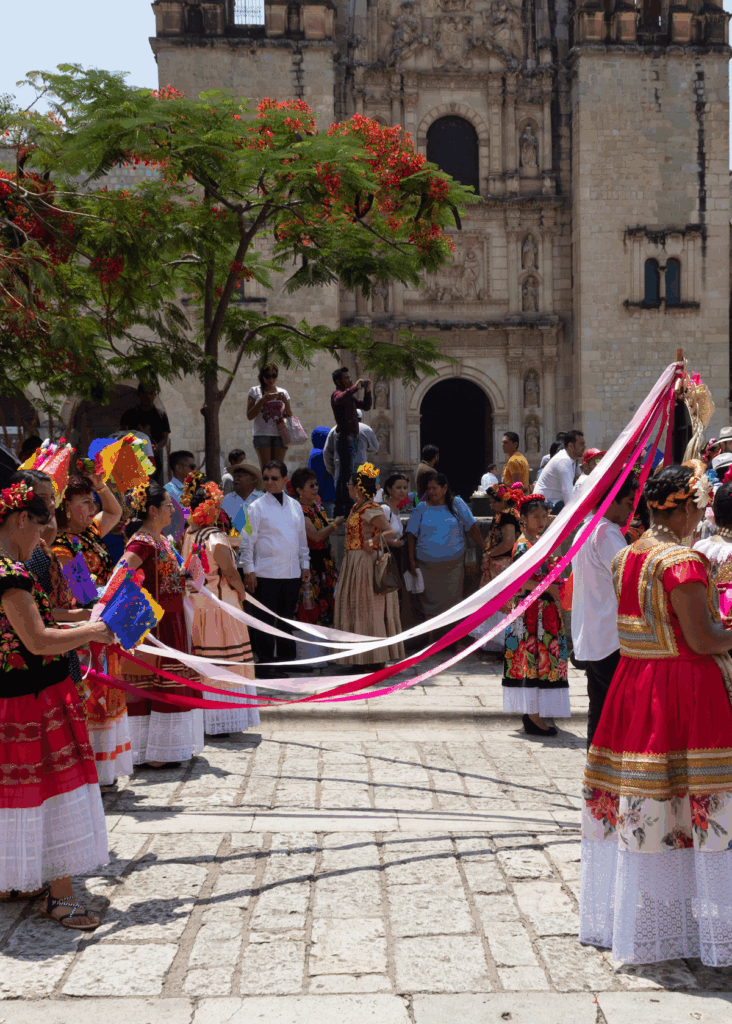
Yes, Oaxaca’s been having a moment for quite some time now, but it’s well-deserved. Oaxaca is a major cultural capital teeming with colors and cool, and it just happens to turn out some of Mexico’s most mouthwateringly coveted food.
If you want to experience Oaxaca at its peak cultural and culinary finest, there’s no better time to visit than July, when the legendary Guelaguetza festival explodes throughout town.
Guelaguetza is a celebration representing the cultural traditions of the state of Oaxaca’s 8 regions. Revelers from all over the country (and the world!) flock to Oaxaca’s premier event, which, technically, takes place on the last two Mondays of July. These two Mondays are when dance delegations from each region perform at the outdoor Guelaguetza auditorium overlooking the city.
However, in true hardcore Mexican fiesta style, Oaxaca is absolutely lit with Guelaguetza celebrations that last the entirety of July. Expect an avalanche of parades, performance, concerts, culinary and cultural events, religious processions, and artistic exhibitions across every last inch of the city, from Oaxaca’s beautiful Centro Storico to its famous artisan markets.
Here’s the thing. Guelaguetza is such a major event that you’ll be hard-pressed to find deals on hotels and flights to Oaxaca, unless you book well in advance. Also, keep in mind that while Oaxaca summer temperatures average a balmy 85° F, there’s a 70% chance of rain on any given day, and the humidity is real. Fortunately, you usually won’t see rainfall until afternoon or evening. This means morning is an ideal time to explore Oaxaca’s charming markets and pre-Columbian, Zapotec and Mixtec ruins until Guelaguetza festivities kick off later in the afternoon. If you don’t mind spending a little extra on travel, don’t let the rain stop you from packing an umbrella and experiencing this incredible event.
Huatulco
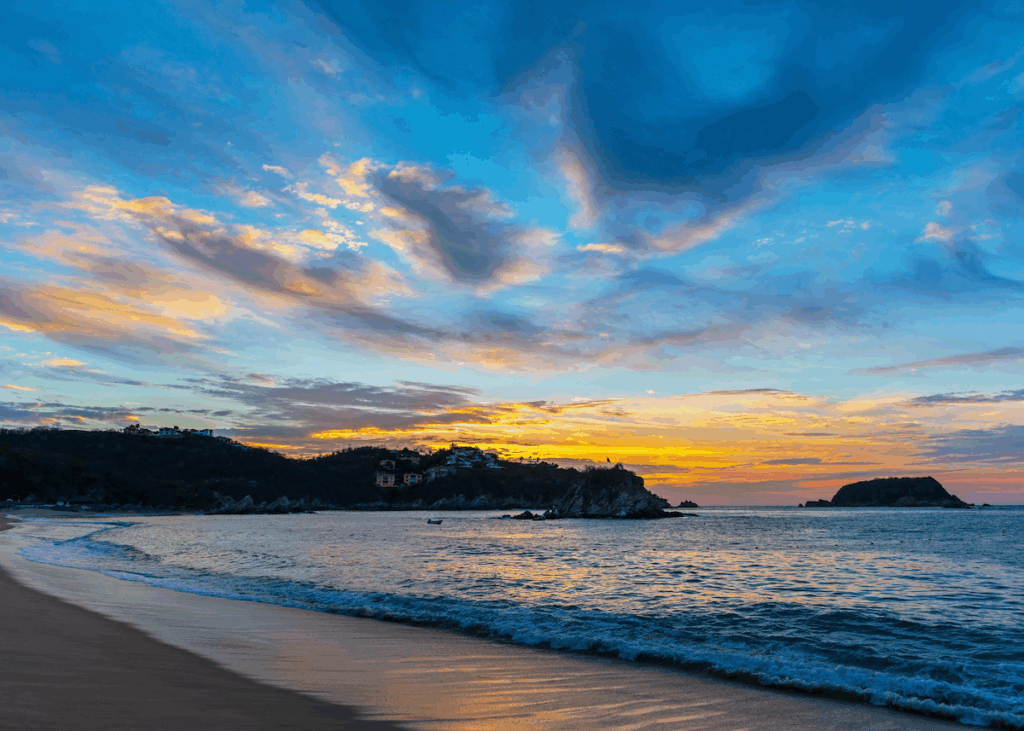
A 5-hour drive from Oaxaca City lies the breathtaking Bay of Huatulco (Bahia de Huatulco), boasting 9 distinct bays which are home to 36 gorgeous Pacific beaches. With its laid back vibes and lush tropical surroundings, Huatulco is an ideal place to relax and cool off by the water after a July spent partying at Guelaguetza. Although keep in mind that Huatulco, like Oaxaca, is no stranger to summertime rain. Fortunately showers are usually fleeting, giving way to warm, sunny days with highs in the low 90s. If you don’t mind a passing shower, Huatulco’s shoulder season is an excellent time to score deals on hotels and stays.
Dancing and music are a way of life in Huatulco. Salseros on the hunt for a groove will find it here the last week of August during the annual Beach Latin Fest, as well as inside Huatulco’s lively bars, nightclubs and mezcalerias in town. Huatulco’s dance and live music scene are heavily influenced by African culture, a result of the Spanish bringing African slaves to work the area’s plantations during colonial times. In fact, the stretch of coastline running from Acapulco to Huatulco, known as the Costa Chica, accounts for the largest population of Black Mexicans in the country.
An eco-friendly paradise, Huatulco offers loads of Mother Nature to explore, particularly in the summertime. July marks the official nesting season of the region’s Olive Ridley sea turtles, an extraordinary sight to behold along Huatulco’s beautiful beaches. One magical benefit of the summer rains is that they bring Huatulco’s spectacular Copalitilla Magical Waterfalls to life, where visitors can swim beneath the refreshing cascades. A wonder to visit any time of year, Huatulco National Park is filled with hundreds of extraordinary animals, including white-tailed deer, salamanders, armadillos, iguanas, pelicans, hummingbirds, dolphins, and turtles.
And you can’t miss Huatulco’s pristine beaches! San Agustin, renowned for its tranquil beauty, Playa La Entrega, popular for its amazing snorkeling, and the white sandy beach of Playa La India are some of Huatulco’s best.
Mexico City
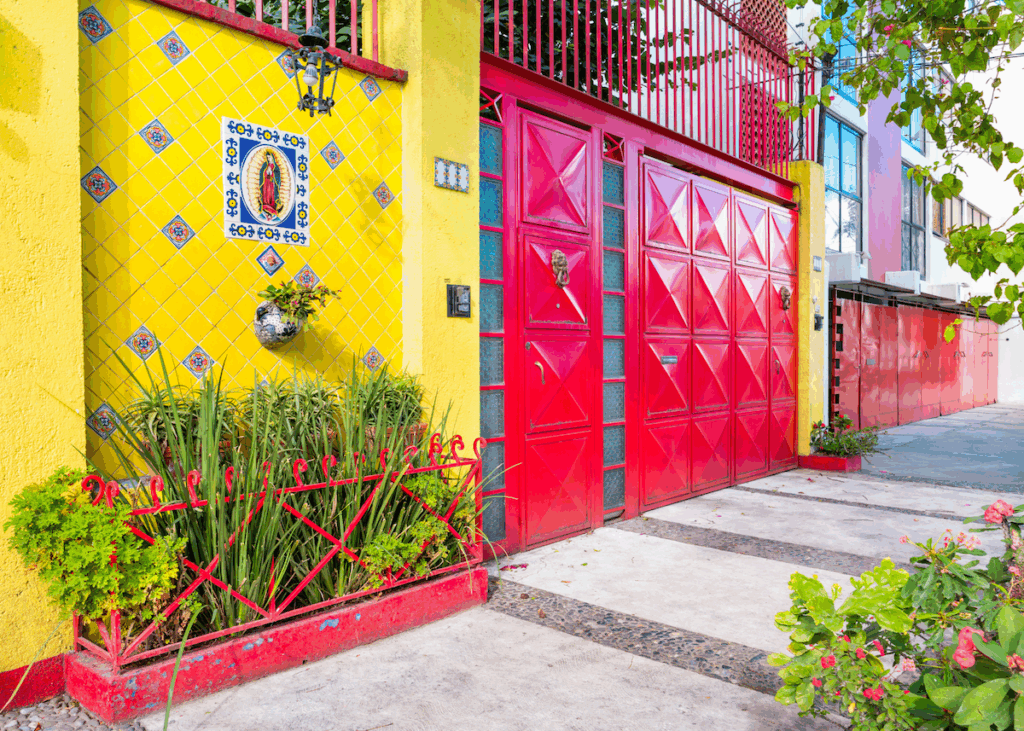
Summer in Mexico City doesn’t disappoint. Sure it’s hot, with highs in the 80s. And the DF does receive about 85% of its annual rainfall in the summer months. Just keep in mind that most showers are brief affairs that hit in the afternoon, and mostly help to cool things down for a pleasant evening.
But a little heat and drizzle is no good reason to skip one of the world’s most fabulous cities during peak party time.
Mexico City’s Gay Pride Festival at the end of June is one of the largest and most joyous celebrations of gender and diversity in the world. The annual Pride Festival draws a staggering 1 million people for mass celebrations that go down in the bars, clubs and streets of Mexico City’s Zona Rosa, the city’s center of gay life. The highlight of the raucous festivities is the Gay Pride Parade, a jubilant, technicolored spectacle of epic proportions that marches from the gold-tipped monument of the Angel of Independence monument all the way to Mexico City’s historic Zócalo. Click here to discover more about the Gay Pride Parade route and other Pride events around Mexico City.
Following Pride, the Mexico City Marathon comes to town during the second week of July. The 21K half-marathon grinds through the streets between the Angel of Independence and the Torre del Cabalito, shutting down countless streets in the famously over-trafficked city. Summer in Mexico City is also a great time to get out in Mother Nature to witness the glowy phenomenon of fireflies in the city, which arrive with the humid, summer rains. You can catch these luminous insects zipping around places like Chapultepec Park and the Tlalpan Forest starting around dusk. Summertime in Mexico City is also prime concert season when you can count on global headliners coming to town. Shakira, Maluma, Imagine Dragons, and Oasis are all set to hit Mexico’s capital this summer.
San Miguel de Allende
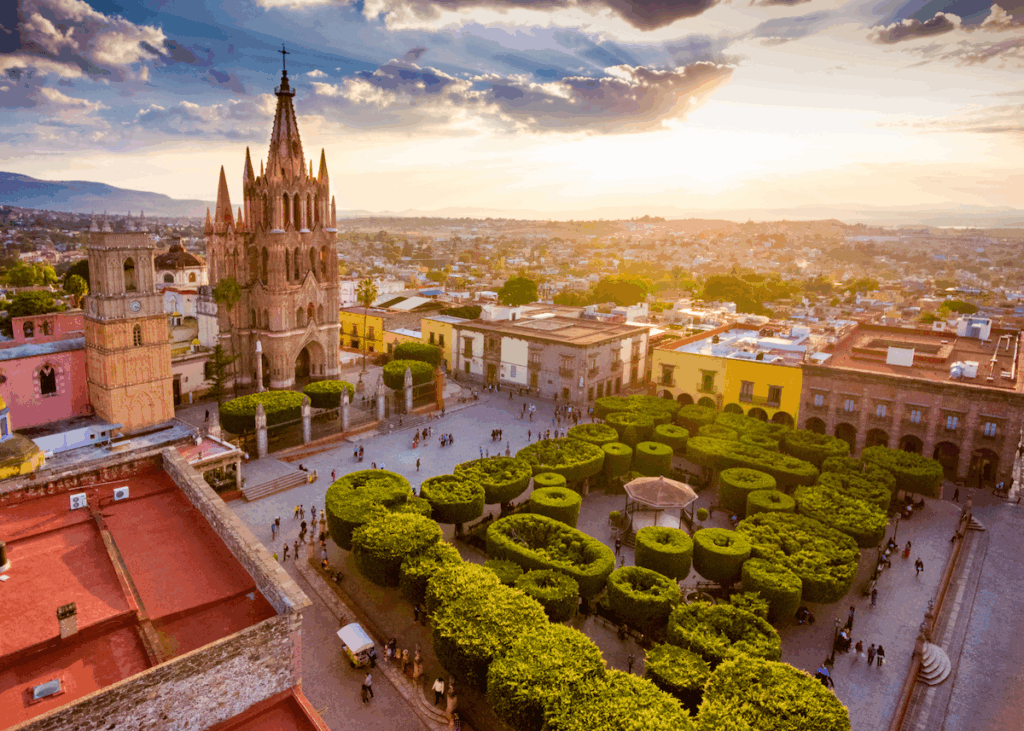
Exploring the picturesque town of San Miguel de Allende is a brilliant idea any time of year, even during the wetter summer months. The colorful colonial city averages about 4 – 5 inches of rain from the months of June to September, but, like in other Mexico cities, showers generally pass quickly.
One of Mexico’s most culturally rich cities, San Miguel de Allende’s Centro Storico is a designated UNESCO World Heritage site. The charming area is packed with postcard-perfect architecture housing museums, art galleries and delicious restaurants that line Old-World cobblestone streets. It’s no wonder San MIguel de Allende is one of Mexico’s most popular tourist destinations. So if you can deal with a spot of rain during the summer months, you’ll find less tourists, along with solid shoulder season deals that arrive just in time to enjoy some of the city’s best festivals.
Visit in late May to catch a host of incredible performances at the San Miguel de Allende International Jazz and Blues Festival. Exciting jazz performances abound at a select smattering of open air and indoor venues around town, from plazas to churches to theaters. If you visit during the third week of June, you’ll catch one of San Miguel de Allende’s craziest local festivals – literally. The Convite de Locos – or “crazy” street party – is a wild and fun tradition that sees locals dressed up like scarecrows, and an assortment of other colorful characters, to holler, dance and parade through the streets to honor the feast of Saint Anthony of Padua. If you prefer your travels a little more mellow, visit San Miguel de Allende in August, when the city hosts the Festival de Música de Cámara, one of the most popular chamber music festivals in the world, which draws over 100 performers from around the globe.
Guanajuato
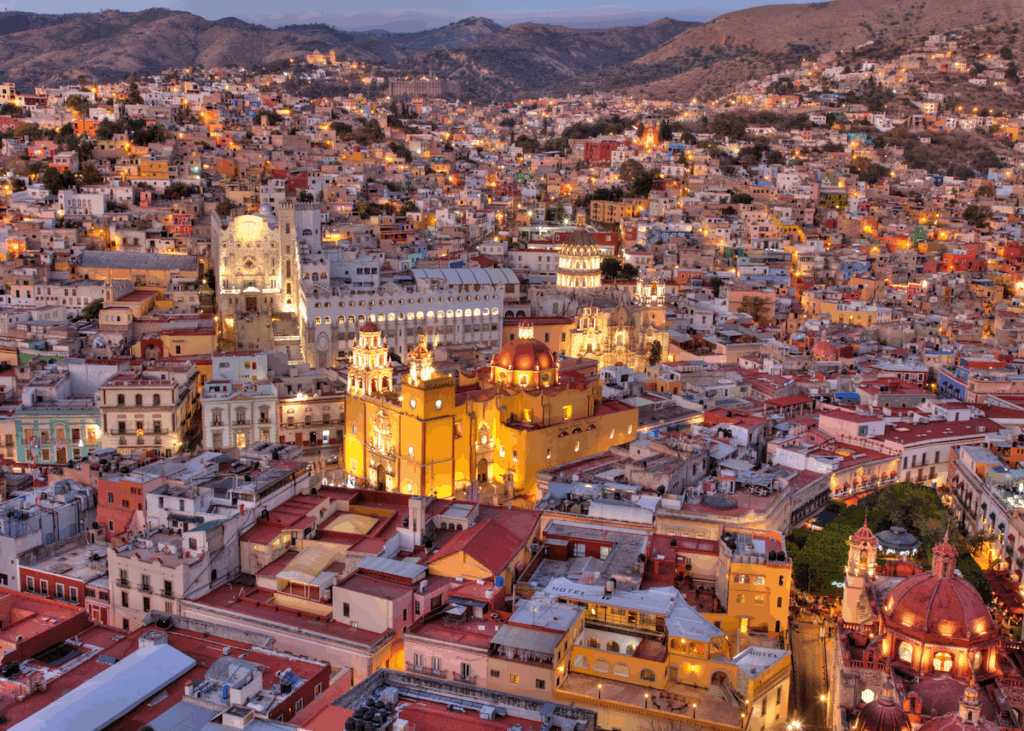
The splendid city of Guanajuato, with its rolling hills, dramatic colonial architecture, pivotal role in Mexico’s independence, and jaw-dropping views (none finer than from the overlook bearing the monument to El Pipilla), is an excellent summer destination. Located in the state of the same name, Guanajuato is just an hour’s drive from San Miguel de Allende, so expect a similar summer climate. Warm days in the low 80s give way to afternoon showers, which make way for refreshing, temperate evenings.
In July, the Guanajuato International Film Festival, one of Latin America’s foremost cinema events, comes to town. 3,500 films are shown throughout impressive venues around the city, including the striking Bicentennial Theater and the celebrated Museum of Art and History. The weeklong festival brings together film industry veterans, Latin American filmmakers and cinema enthusiasts, making it one of Mexico’s most important cultural events.
On a completely different note, beer enthusiasts visiting Guanajuato in July are in for a treat with the Craft Beer Expo, or Expo Cerveza Artesanal, which celebrates its 10th year in 2025. The 3-day festival is filled with great food and live music, and of course promotes beer made by local, small batch brewers and large Mexican producers.
La Paz
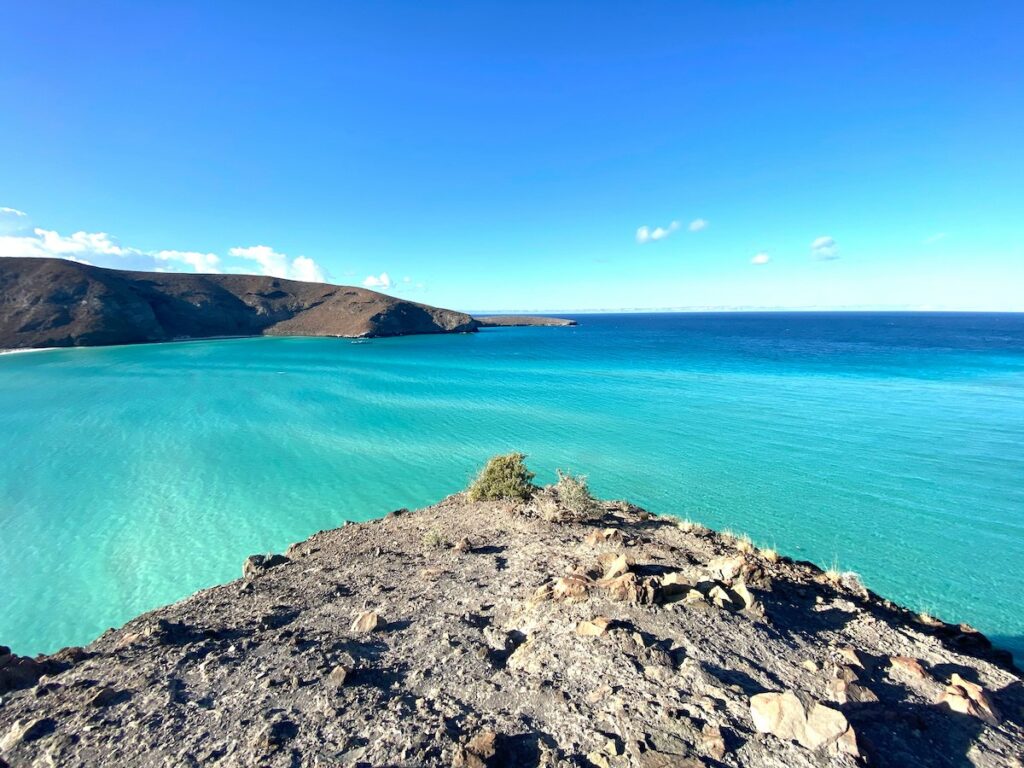
Nestled dramatically between rugged mountains and a pristine stretch of the Sea of Cortéz, La Paz is a standout Mexico beach destination. True, summer temps in La Paz can be scorching, with bright, sunny days blazing up to 97° F. But while the majority of Mexico’s best beach towns are drenched in summer showers, historically, La Paz only gets about 4 measly days of rain all summer. Summer is also low season, so there’ll be less crowds blanketing the magnificent beaches, and you should find some good hotel deals.
With 20 beautiful beaches in La Paz, and several more stunners further afield, you’ll have your pick of where to swim, kayak, paddle board, snorkel, or just plain old beach bum it. Playa Balandra, with its shallow coves, powdery dunes and famous mushroom-shaped rock-formation, El Hongo, is a top choice. The prestigious Blue Flag beach of El Coromuel is an idyllic spot to catch the surreal sunset.
Beyond the beach, La Paz offers mucho to do in the way of activities. You can stroll the 3-mile malecón, check out the art scene, and go “sandboarding” (which is kinda like snowboarding) in the desert terrain. Hiking is another great La Paz activity, with the hike above Balandra Bay, and the trail up to Calavera, being two of the most popular and beginner-friendly. Just make sure to head out early and don’t forget water and sunscreen in the summer temps!
An eco-tour of Espiritu Santo Island is an absolute must while you’re in La Paz. Often referred to as the “Galapagos of North America,” Espiritu Santo is a biosphere reserve and UNESCO World Heritage Site (Mexico boasts 35 of these!) known for its pristine beaches which are filled with extraordinary marine life. Tours are a full day out, usually lasting between 5 – 8 hours. You’ll have the chance to snorkel through crystalline waters with incredible creatures like sea lions, manta rays, dolphins, turtles, and even whale sharks!
Puerto Peñasco
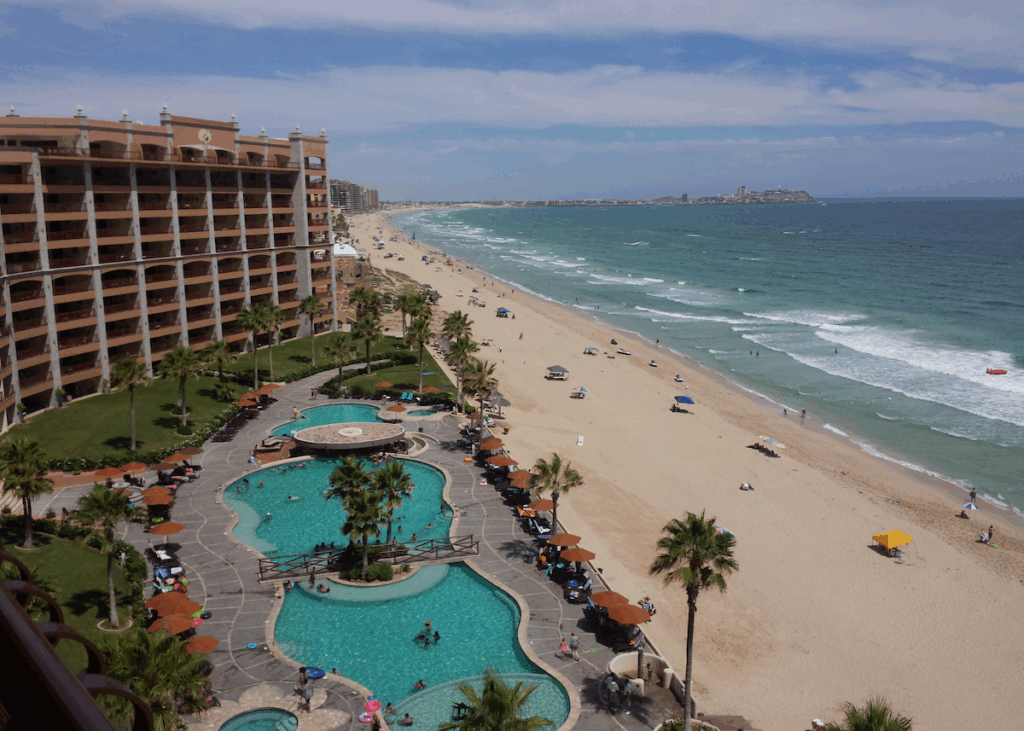
Just 60 miles from Mexico’s border with Arizona you’ll find the beach town of Puerto Peñasco, long an easy escape for those itching to ditch the landlocked desert heat. Situated on the Sea of Cortés in the highland state of Sonora, Puerto Peñasco’s year-round high is a warm and perfect 84° F that’s free of the humidity you’ll find in Mexico’s southern, tropical beach towns.
Puerto Peñasco, or Rocky Point as its called in English, has lots to do. The town is filled with open air markets by day, and there’s a bustling nightlife along the beachfront malecón once the sun goes down. Puerto Peñasco is an outdoor enthusiasts dream, offering a range of adventurous activities like horseback riding, kitesurfing, scuba diving, kayaking, parasailing, and plenty of beachfront for cutting loose on ATVs. Avid golfers will love hitting the links at the swanky Las Palomas Beach & Golf Resort, an 18-hole, Par 72 luxury golf course.
No trip to Puerto Peñasco is complete with an eco-tour of Isla San Jorge, an island nature reserve 30 miles off the coast. Also known as Bird Island, this rocky patch of land is famous for it 3,000 seal and sea lion inhabitants, the largest population of such creatures anywhere in Mexico. Bring a swimsuit so you can join them for a swim, and don’t forget your binoculars. As the name Bird Island implies, this is an excellent spot for birding, with winged wonders like swallows, blue-footed boobies and pelicans sailing through the skies overhead.
Cabo San Lucas
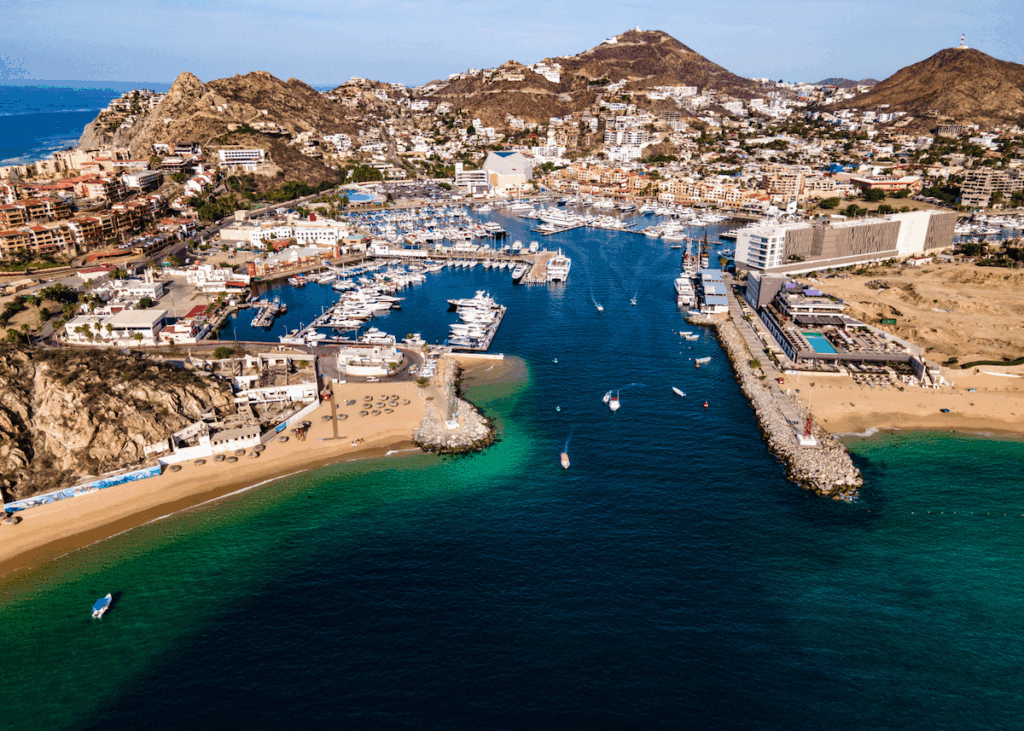
Summer is a stellar time for grabbing travel deals in Cabo San Lucas, everyone’s favorite, Mexico luxury resort town. Shoulder season prices can put an otherwise pricey resort well within your budget. If you want to avoid peak crowds, plan your Cabo escape for June, before families and snowbirds flock here during the more popular months of July and August. Just keep in mind that summer in Cabo is blazing. Expect muggy days with highs in the 90s, and warm evenings in the 70s.
Summer is also Cabo’s rain and hurricane season, which lasts from mid-May to late November. In 2023, Hurricane Norma brought high winds and major flooding to the area, while Cabo was devastated by Hurricane Odie back in 2014. While hurricanes are very real, in truth most seasonal storms in Cabo happen in September, and they’re often out at sea. It’s always good to stay aware of the risks, but chances are you’ll enjoy a fabulous, lower-cost Cabo getaway with exquisitely warm water, smaller crowds and sunny skies.
Otherwise, summer in Cabo is a sporty time of year with a few awesome competitions to check out. In June, Cabo’s coveted beaches host the Los Cabos Open Surf, one of Mexico’s best surfing events that combines world-class talent at the sea with a live music festival on land. Also in June, the Mifel Tennis Open comes to the Cabo Sports Complex from the 14th – 19th. Last year’s event drew over 30,000 tennis fans to the annual international men’s tournament, which also includes plenty of activities, music, food.
San Luis Potosi
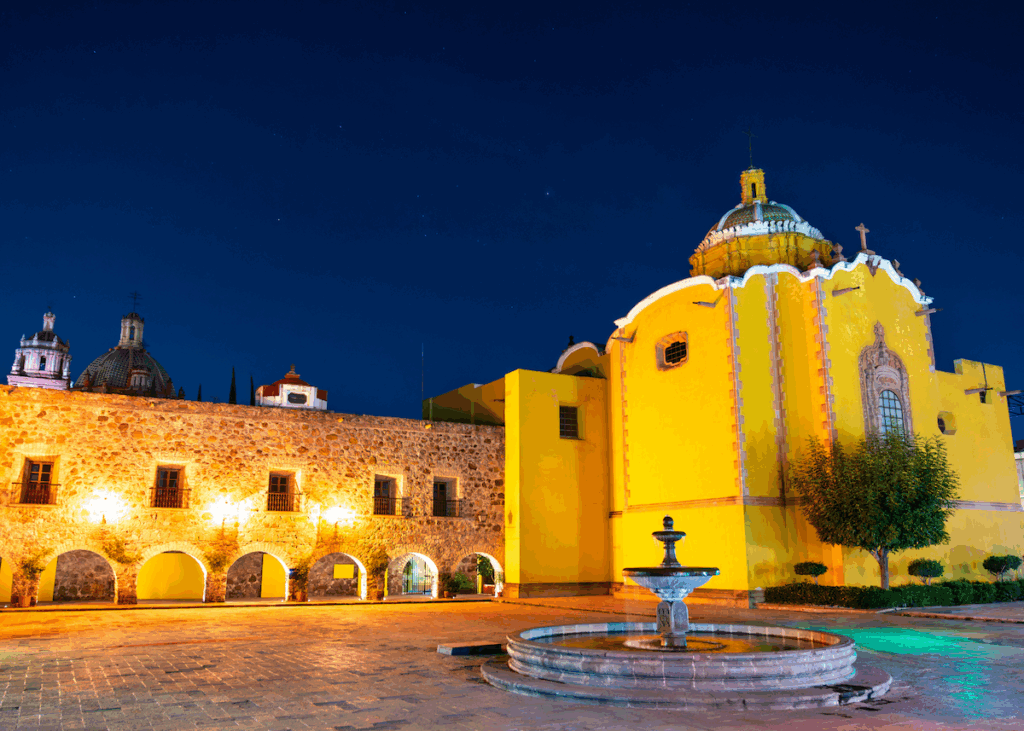
The lovely colonial city of San Luis Potosi, situated in the state of the same name, is one of Mexico’s best kept secrets. A mining town put on the map when gold and silver were discovered here in the 16th century, San Luis Potosi’s historic downtown is a designated UNESCO World Heritage Site. This is owing to its importance as part of the Camino Real de Tierra Adentro, also known as the Silver Route, a road built by Spanish Royals that stretches all the way to New Mexico.
San Luis Potosi’s historic center is eye-poppingly pretty. It’s brimming with a stunning fusion of architecture that includes Baroque bell towers, religious domes and stately, colonial and beaux-arts buildings. Pink cantera limestone was used to construct many of these old buildings, lending a unique softness and mesmerizing hue to the delightful plazas scattered throughout San Luis Potosi’s pedestrianized center.
Today, San Luis Potosi is a flourishing cultural hub where you’ll find it hard to run out of things to see and do. More than 500 historical monuments exist in Centro Storico, which is also home to a breadth of museums, art galleries and buzzy restaurants that now inhabit its timeless buildings. Take a fascination stroll down the Calzada de Guadalupe, which, at 2 miles in length, is the longest pedestrian street in the Americas. There’s some wonderful museums in San Luis Potosi, the most interesting of which is the Leonora Carrington Museum, which features a collection of surrealist sculptures by the British-born artist set starkly inside a former prison. And don’t miss Tangamanga Park, a divine green space with a large lake canopied by trees. It’s Mexico’s second largest park in the country after Chapultepec in Mexico City.
San Luis Potosi gets its summer fiesta on at the end of August with the Potosina National Fair (Feria Nacional Potosina), a nearly 3-week citywide event featuring major global and Mexican acts. The 2024 version featured a diverse lineup including Maluma, Black Eyed Peas, Gloria Trevi, and Steve Aoki. The 2025 lineup has yet to be announced.
Guadalajara
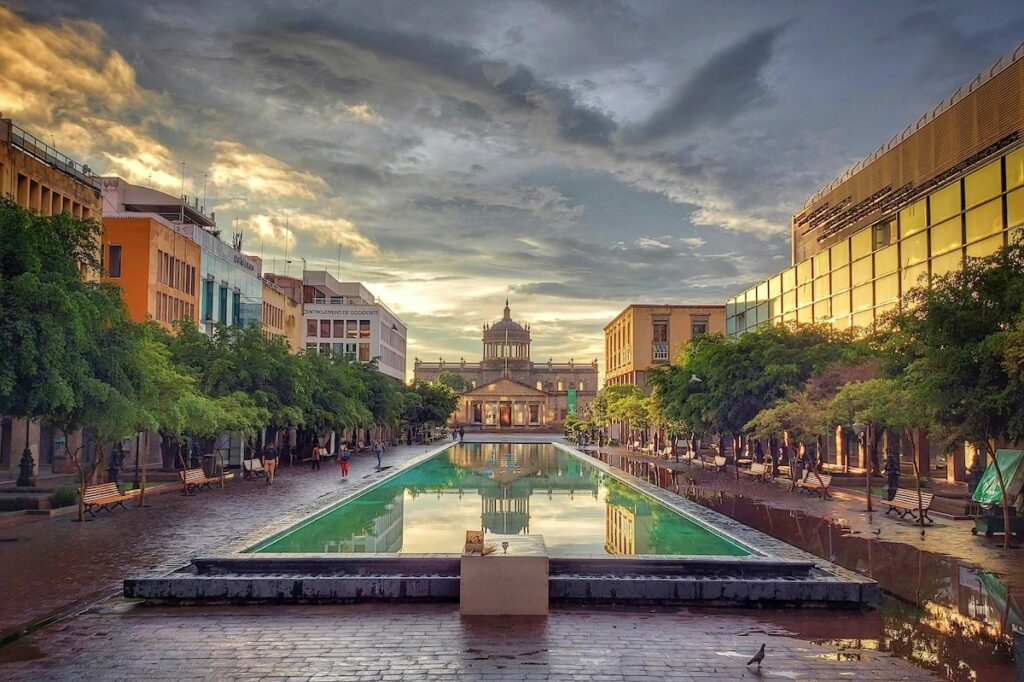
Guadalajara, the bustling state capital of Jalisco, is the birthplace of Mariachi music. For many of us, just the sound of the word “Mexico” conjures the spirited rhythm of this traditional, string and brass-heavy music. So if there’s one event in Mexico’s second biggest city that’s worth braving the wet and warm summer for, hand’s down it’s the International Mariachi Festival (Encuentro Internacional del Mariachi y la Charreria).
Every year Guadalajara hosts Mexico’s biggest homage to this jubilant genre of music. The ten day event kicks off the final Sunday in August, when tapatios pack the streets as musicians and charros from around the globe, decked out in epic Mariachi costumes, parade through Guadalajara dancing and riding on horseback, all while playing their distinctive music. Over the following days, a host of incredible concerts and dance performances at various venues follow. The most unmissable of these is the Galas de Mariachi, held at the stunning Teatro Degollado. The concert is a symphonic blend of traditional and classical music, with top mariachis playing alongside the Guadalajara Philharmonic Orchestra.
Craving even more music? On July 1st, the Jalisco Jazz Festival arrives in Guadalajara and lasts more than a month, until August 6th. It’s the most popular jazz festival in Mexico (sorry San Miguel de Allende!), with previous editions drawing over 130 national and international musicians. You can find free concerts and activities all over the city during this time, making for some wonderful budget-friendly entertainment.
It’s also worth planning a few day trips to Guadalajara’s surrounding pueblos magicos, or magical towns. Just a 30-minute drive from downtown Guadalajara you’ll discover the magical town of San Pedro Tlaquepaque, where the Feria de Tlaquepaque kicks off for 2 weeks starting every June 15th. It’s a great family outing with concerts, cultural events, rides, crafts, plenty of traditional food, and loads of activities for kids. For the ultimate summer getaway in the area, head an hour south of Guadalajara to glorious Lake Chapala, Mexico’s largest natural lake, where you can meander through the lakeside towns of Chapala and Ajijic. Both towns offer lots to do, with hiking, boating, canoeing, kayaking, horseback riding, and scouting local flora and fauna being some of the most popular activities.
The Wrap
I hope this article inspires you to summer in Mexico! With the season just around the corner, which awesome destination will you choose? Personally, I’m braving the July crowds in Oaxaca to celebrate my birthday this year. I can’t wait to share all of my Oaxaca tips and travel secrets with you!
If you’re interested in what’s on in Mexico during the opposite season, check out my top picks for the best winter in Mexico destinations so you can start planning now. Winter is definitely the best time of year to explore the wonders of the Yucatan Peninsula, which are less than idyllic in the summer. If you plan to hit the Caribbean this holiday season, you’ll definitely want to check out my article, Christmas in Cancun.
Thanks for hanging out ’til the end! As always, inspired travels! 💜



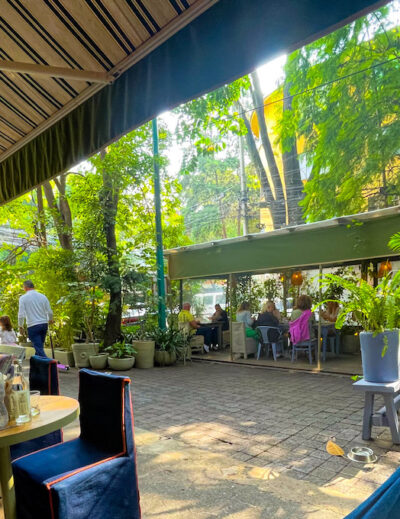
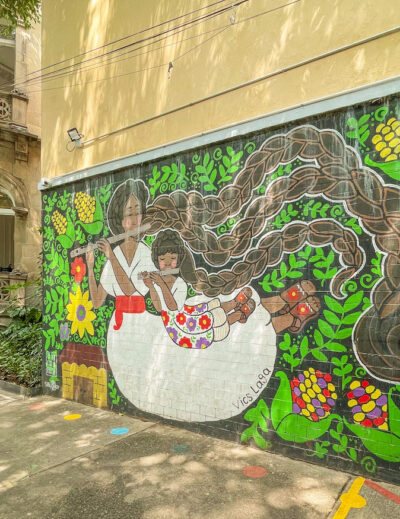
Leave a Reply